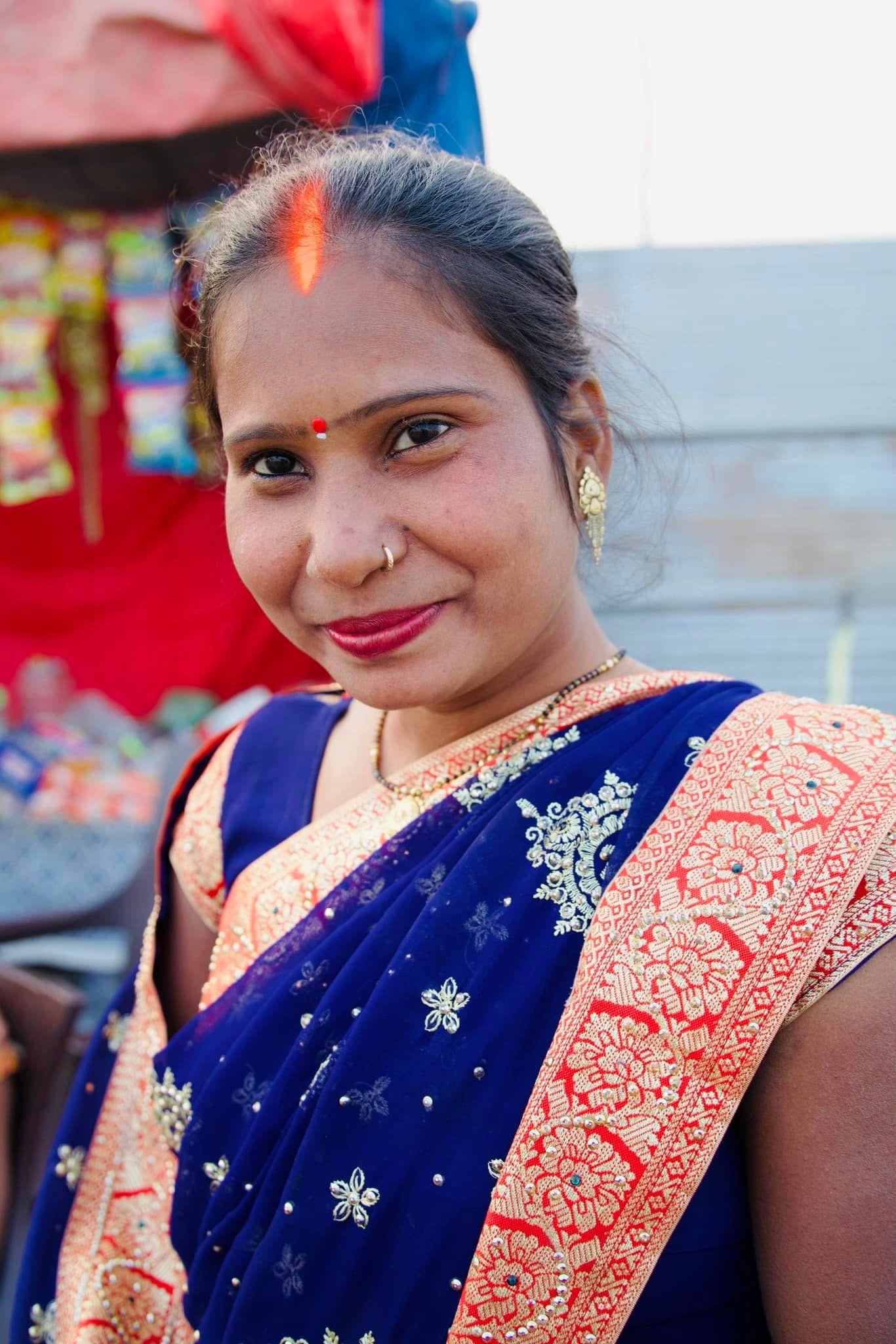
Sacred Gatherings:
The Maha Kumbh Mela
When I initially booked my flight to India months prior, I had no idea the Maha Kumbh Mela would be unfolding while I was there. But divine timing works in mysterious ways, especially every time I return to India. It’s as though the universe places you exactly where you need to be. So, after my time in Varanasi, I made my way to Prayagraj, where I spent five transformative days immersed in the largest peaceful spiritual gathering in human history. The Maha Kumbh Mela is far more than a festival; it’s a sacred pilgrimage for millions who believe it offers the possibility of spiritual liberation. At the holy confluence of the Ganga, Yamuna, and Saraswati rivers, I found myself drawn into an experience that connected me with something far beyond myself. This was not just the largest spiritual gathering in history- it was a deeply transformative moment that I would remember for the rest of my life.
It was an extraordinary mission to get to the Kumbh Mela that morning, and against all odds, I somehow made it. Everyone I spoke to told me it was impossible- buses weren’t running, roads were shut, and with over 400 million people descending on Prayagraj, the police had sealed off nearly every way in. But when I’m told something can’t be done, my instinctive response is simple: “Watch me.”
It took two hours of wading through Varanasi’s chaos- rickshaws, cows, and waves of people moving like a tide- just to reach the crowded bus station, only to be told there were no buses going to Prayagraj. But India runs on connections, and fate has a way of bending when you push hard enough. I met a guy who knew a guy whose cousin had a brother who might know a way. A few phone calls, some frantic negotiations, and I was on one of the last buses heading toward the Kumbh.
Four hours later, the bus dropped me in the middle of nowhere, and I found myself standing in a dusty street, unsure of how to proceed. After a quick conversation over chai and more negotiating, I found myself on the back of a motorbike, speeding through the chaotic streets of Prayagraj towards the river. Two boat crossings later, drifting through chai-coloured waters, the energy of excitement and devotion thick in the air, and I finally arrived.
Nothing could have prepared me for the Kumbh Mela. The sheer scale of it was beyond words. An entire city, conjured from nothing, sprawling in every direction, alive with movement, prayer, and purpose. I’d never seen anything like it in my life.
Rakesh Gaur with his beautiful family: daughter Khushboo Kashyap, wife Reena Gaur, and daughter Kritika Kashyap.
The Kumbh Mela’s Spiritual Significance
The Kumbh Mela is much more than a festival; it is a living expression of spiritual renewal. Every 12 years, millions gather at the sacred confluence of the Ganga, Yamuna, and Saraswati rivers, believing that immersing themselves in these waters will purify their sins and bring them closer to moksha. The Kumbh represents the highest form of devotion, where the body, mind, and soul seek liberation from the weight of past lives.
The mythology surrounding the Kumbh Mela stretches back to ancient times. It is said that when the gods and demons fought over the nectar of immortality, it spilled into four places across India. One of these sacred spots is Prayagraj. The Kumbh Mela is named after the ‘Kumbh’ or pot that held this nectar, symbolising the abundance of life and the possibility of immortality. But the waters here are more than just physically cleansing- they’re believed to cleanse the soul and purify karma.
A central part of the Kumbh's spiritual significance is the idea of the unseen river, Saraswati. While the Ganga and Yamuna are visible to the naked eye, Saraswati flows underground, hidden from view. This invisible river represents the hidden spiritual forces that shape our lives, our souls, and the universe. The belief that bathing here can cleanse not only one’s personal sins but also one’s ancestral karma speaks to the deep connection between the living and the dead. The Kumbh Mela is both a personal and collective pilgrimage, seeking purification not just for oneself but also for one's family, both living and deceased.
Link to Varanasi’s Death Rituals
In both Varanasi and at the Kumbh Mela, spirituality, death, and rebirth are ever-present. The themes of life, death, and rebirth are interwoven with the sacred rivers in both places. In Varanasi, where people come to die, the belief is that passing away here and being cremated on the banks of the Ganges leads to moksha, liberation from the cycle of rebirth. Similarly, at the Kumbh Mela, pilgrims seek to cleanse themselves in the waters, hoping that they, too, will transcend the cycles of samsara.
The act of purification at the Kumbh Mela mirrors the death rituals in Varanasi, where the river is aa passage for life and a bridge to the afterlife. Pilgrims come to the Kumbh Mela not only for personal salvation but for the salvation of their ancestors, hoping that the act of purification will extend to their family lines, easing the suffering of those who have passed on.
Taking a Dip in the Sangam- Death, Purification, and Ancestral Karma
Taking a dip in the Sangam—the sacred confluence of the Ganga, Yamuna, and the mythical Saraswati—is at the heart of the Kumbh Mela. Arriving early, before the crowds swelled, I stepped into the cool waters, surrounded by the ebb and flow of the sacred rivers. There’s something profoundly humbling about immersing yourself here, with the belief that this act can wash away lifetimes of accumulated karma.
As I sat on the banks, I watched families—grandparents, parents, children, aunts, and uncles—enter the water together. Seeing multiple generations take part in this sacred ritual was deeply moving. The Kumbh Mela isn’t just an individual journey; it’s a collective one, bound by family, community, and the spiritual lineage that ties past, present, and future. The rivers are believed to cleanse not just the body but the entire family line, freeing both the living and their ancestors from the weight of karma.
There is a unique power in witnessing thousands of people come together with a shared purpose, each hoping to purify not only themselves but also those who came before them. The belief that karma is passed down through generations makes this ritual more than personal—it’s an act of devotion that spans lifetimes. Standing by the river, I felt the energy of countless bodies moving around me, the air alive with the rhythm of prayers and flowing water. The act of purification transcends the self, becoming a bridge between generations, a link between the seen and unseen, and a testament to the enduring spirit of those who gather at the Sangam.
The Kumbh Mela Chaos
The sheer scale of the Kumbh Mela is overwhelming, and the experience is one of both awe and exhaustion. The sounds, the smells, the colours- everything at the Kumbh is magnified. Conch shells echo across the riverbanks, temples fill the air with the sound of bells, and the smell of incense and food wafts through the crowded streets. As I moved through the throngs of pilgrims, I was swept up in the energy, which was as chaotic as it was sacred. Everywhere I turned, there were people engaged in rituals, prayers, or simply walking with purpose toward the river, ready to immerse themselves in its cleansing waters.
Despite the crowds, there was an undeniable sense of peace among the people. It was as if everyone was united by a singular purpose- a devotion to the divine, to moksha, to the sacred act of purification. But there were also moments of complete disorientation. I was swarmed by thousands of people eager to take photos with me, their curiosity about a foreigner at the Kumbh Mela palpable. I was interviewed by several camera crews, something I was not entirely comfortable with, but which felt oddly inevitable given the atmosphere. The spotlight is not my place of comfort, and yet, amidst the overwhelming attention, I felt like a small part of something much bigger, something that transcends individual identity and touches the divine.
When I left the Kumbh Mela, my lungs were full of dirt and ash, my belly full of chai and thali, and my mind- reeling, trying to make sense of it all. The experience had overwhelmed me in the best possible way. The Kumbh Mela was an absolute force—an unyielding collision of faith, chaos, and transcendence. And somehow, I was pulled deep into its current, swept along by the devotion that flowed more powerfully than the Ganges itself.
As I tried to make my way out, exhausted and reeling, fate led me to Rakesh. A chance encounter that somehow felt inevitable amidst all the chaos. He guided me beyond the ordered disorder to meet his beautiful family, a moment of connection amidst the overwhelming energy of the Kumbh. That moment, and everything that followed, would stay with me long after I left the Mela, a reminder of how faith, devotion, and chaos collide in the most unexpected of ways.



















































































